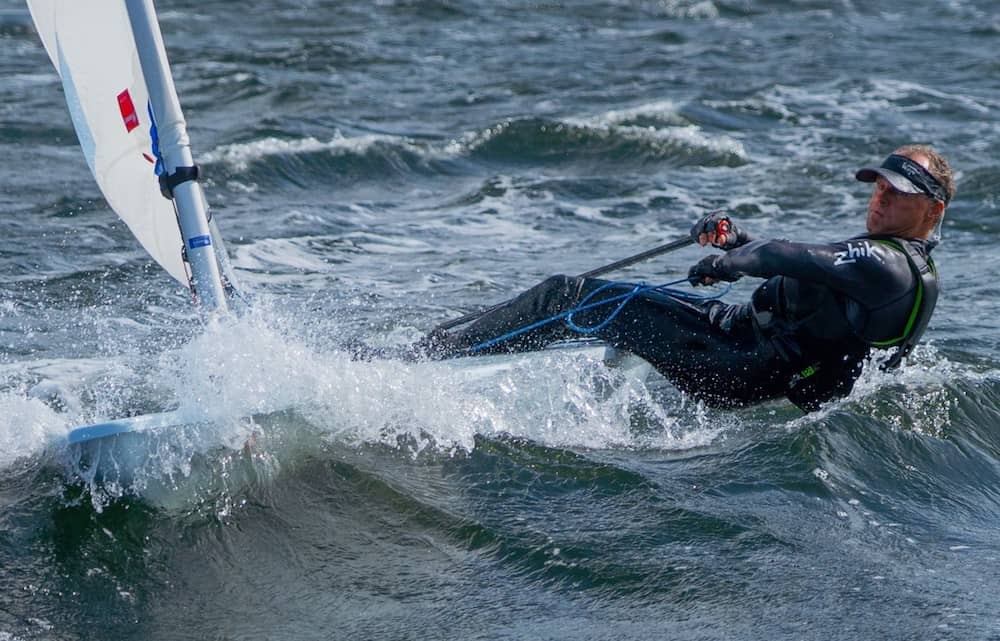Sailing Knees
Life is short. There are only so many windy days in any given knee. A little preventive maintenance, lubrication, early repair of broken rigging, and replacement of worn-out parts keep boats and knees on the water.
Melges 32 World Champion, match racing sailing champion, and Stone Clinic patient: Andrew Holdsworth.
In the sailboat analogy, the ligaments are the stays and shrouds of the knee joint. The ACL and PCL act as the forward and aft stays, extending from the top of the femur to the anterior and posterior tibia. The mast, when stays are torn on a sailboat, comes down—when the ligaments are torn in the knee, the tibia shifts out of place on the femur. This is called a pivot shift, and damages all the adjacent structures. The MCL and LCL are the shrouds stabilizing the sides of the knee. On a boat, these structures, when torn, cause side-to-side swaying. This is true in the knee as well.
The meniscus is the fibrous shock absorber and stabilizer of the knee. One on each side of each knee, medial and lateral, they distribute the force of bodyweight as it is transferred from the femur to the tibia. These are torn over a million times a year in U.S. knees alone—and 90% of the time, tragically, a surgeon removes the torn tissue, leaving the tibia exposed and dooming the knee to arthritis. The sailing analogy here would be the gaskets in the boat’s engine. Once torn, they leak fluid. Trimming them does not help.
The articular cartilage of the knee is the gel coat on a boat’s deck. A shiny white, slick surface without cells or blood vessels, it protects the bone underneath. If uninjured, it can last a lifetime of running or sailing. But it has no natural healing properties—so once dented, cracked, or stripped away, the bone below dries out, hardens, and deforms over time. Arthritis begins with the wearing away of the articular cartilage and ends with a bone-on-bone deformity in the knee joint.
The knee joint is enclosed in a capsule, with a lining called synovium. Filled with cells and blood vessels, this organ provides lubrication and nutrition for the joint. A swollen knee is characterized by a thickened synovium, inflamed tissue, and excess fluid. It is the waterlogged wooden dingy left to rot in soggy weather.
Dr. Stone's talk to the prestigious St. Francis Yacht Club in San Francisco: "Sailing with Arthritis, Stem Cells, BioKnees, Novel Resurfacing" (September 30, 2020)
Fresh from the factory, boats and knees share commonalities. Everything is supposed to work—yet nothing works as well as it could. Most often, operator error leads to damage. Here is the outline of our 12-step program to keep your knees on your boat this year, and for many years to come:
- Prevention: Many injuries are mental errors. Keep your head in the game and your cell phone on the dock.
- Optimize your nutrition and weight. You take 2-3 million steps each year (at up to 5 times your body weight). Losing 10 lbs. potentially means taking 50 lbs. off your knee. Fuel your body with lean protein, now often plant-derived. Hydrate with water as your primary beverage.
- Fitness. Flexibility matters. Tight muscles and joints are more often injured. Strength, power, and cardiovascular fitness all protect the joints.
- Muscle and bone restoration. Resistance exercise is the only way to build bone and diminish natural age-related osteoporosis. Hike hills and lift weights when not on the boat.
- Lubrication. People and joints alike dry out, especially when injured. Glucosamine supplements decrease joint stiffness. Natural hyaluronic acid injections can be augmented with growth factors from blood and birth tissues. Do not just live with an arthritic joint.
- Inflammation. Shut down inflammation—but not with cortisone. Short-term NSAIDS (such as Advil and Aleve) may help, but they inhibit bone and collagen formation. For joints, potent anti-inflammatory injections are being optimized to shift the balance from catabolic to anabolic environments. It is still not clear if anti-inflammatory diets work, but lowering stress definitely does. Sail more, work more efficiently.
- Surgically repair damage. The earlier the better. The old thinking was that articular cartilage could not be repaired. Now we know it can actually be regrown inside the knee.
- Replace damaged or missing tissues. Ligaments and meniscus are now available off the shelf, though not yet available on Amazon. Donor tissue works extremely well—especially when augmented by growth factors and reparative cells. Sailing and playing without your meniscus and its stabilizing ligaments leads to early sinking.
- Partial bionic replacements work. Eighty percent of people told they need a total knee do not need one. A biologic replacement with tissues may be an option. If there is bone-on-bone in only one part of the knee, a robotically guided partial knee replacement solves the problem—without sacrificing the healthy tissue in the remaining knee.
- Reimagined total knee resurfacing. Not your father’s knee replacement. With the extreme accuracy of robotic cutting guides, metal components with a porous undersurface can be used. These amazing parts permit your bone to grow into them—literally becoming part of you. Previous worries about using unstable cement to hold these parts in place are resolved. You can go back to full sports—and are, in fact, encouraged to. The more you exercise on these components, the better you will do.
- Rehab like there’s no tomorrow. See yourself as an athlete in training, not as a patient in rehab. Focus on more than just the knees. No patient with an arthritic knee has normal mobility in other joints. Exercise 7 days a week, but never while distracted by reading or watching TV. Set your goal to become fitter, faster, and stronger than you have been in years.
- Play Forever. Sail forever. Drop dead at 100, tacking on the water or doing wherever makes you smile.

